Aphids

These small, soft-bodied insects are pear-shaped, measuring 1/16” to 1/4” long. There are approximately 4,000 aphid species worldwide, ranging in colors from green, yellow, brown, red or black. Adult aphids are typically wingless, but some can grow wings. On the tip of the head, there are two whip-like antennae, and on the back end, a pair of tube-like structures called cornicles.
Aphids are common on indoor and outdoor plants, including most edibles and ornamentals. They cluster densely on vulnerable new plant growth and suck plant juices from the undersides of the leaves. Plants can usually tolerate some aphid feeding without issue, but an infestation can result in stunted growth, leaf wilt, curling, yellowing and loss.
As the aphid feeds, it secretes a sticky brown fluid called honeydew. The gooey substance drips on to plant leaves, attracting ants and stimulating growth of black sooty mold.
Regular inspection of plants is necessary to prevent infestation. Aphids blend in well with leaves, so they may not be easy to spot at first. During certain times of the year, female aphids give birth to live young, which reach maturity and give birth to their own offspring within a matter of weeks. This exponential population explosion can result in a rapid infestation if left unattended.
Aphids can be eliminated using organic control techniques. To prevent an aphid infestation in your garden:
- Keep your soil nitrogen levels balanced to prevent plants from growing too rapidly. An excess of tender new growth is an environment that aphids love.
- Employ the assistance of beneficial insects like ladybugs and lacewings to feast on your unwanted aphid guests.
- Remove aphids from affected plants by dousing with a strong spray of water to reduce their numbers considerably.
- Use Earth’s Ally Insect Control to provide a quick knockdown of aphids by covering the plant thoroughly, including leaves and stems.
Thrips
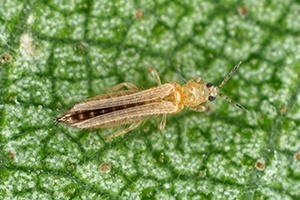
Thrips are very small (1/25”) straw-colored or black, slender insects that are difficult to see without a magnifying glass. These fast-moving insects have two pairs of feathery wings and are commonly found in greenhouses and outdoor gardens. There are over 6,000 species of thrips worldwide. Thrips reproduce rapidly, resulting in 15-20 generations each growing season.
Thrips damage plants feeding in large groups, sucking plant juices and scraping at fruits, flowers and leaves. They prefer new, rapidly growing plant tissues. Thrips can be found on fruit and vegetable crops, including asparagus, lettuce, cabbage, peas, carrots, beans and onions, along with many flowers, including roses. Adults and wingless larvae are attracted to white, yellow or light-colored blossoms.
Thrip infestation can be verified by observing their droppings, which look like black, shiny speckles, along with numerous silvery scars on plant parts, called stippling. Plant leaves may be pale or splotchy. Thrip feeding typically causes only moderate damage, but in severe cases, deformed growth may be observed. Thrip extraction of plant juices can sometimes prevent buds from opening. Some species of thrips can also spread tomato spotted wilt viruses.
You can control and prevent thrips by checking plants frequently and using these organic control techniques:
- Remove all weeds and grass from around the garden to eliminate alternate hosts. Use mulch to prevent weed growth.
- Employ the assistance of beneficial insects like pirate bugs, ladybugs and lacewings to attack and destroy all stages of thrips.
- Remove thrips from affected plants by dousing with a strong spray of water to reduce their numbers considerably.
- Use Earth’s Ally Insect Control to suffocate thrips by covering the plant thoroughly, including leaves and stems.
Whiteflies
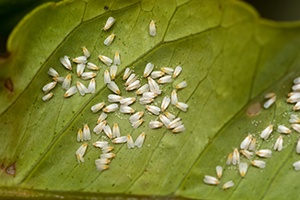
Whiteflies are soft-bodied, winged insects that are somewhat triangular in shape and as small as 1/12” long. They are closely related to aphids and mealybugs and have powdery white wings with short antennae.
These pests enjoy warmer weather and are often found in mid- to late-summer in most regions. Whiteflies inhabit outdoor gardens year-round in southern and coastal states, while northern regions tend to only see persistent infestations in greenhouse environments. They are active during the daytime, making them easier to spot.
Whiteflies damage plants by sucking plant juices and producing a sticky substance, called honeydew. This feeding causes the plant to weaken and leaves to wilt, turn pale or yellow. Plant growth may be stunted, and the honeydew left on leaves can attract ants and lead to formation of fungal diseases. Affected plants include indoor plants, ornamentals and vegetables such as tomatoes, eggplant, okra, peppers, citrus, sweet potatoes and cabbage.
Whitefly infestation can be confirmed by observation of swarms of winged adults flying around when affected plants are disturbed. About 200-400 eggs are deposited in circular clusters on the undersides of the plant’s upper leaves, hatching in just 5-10 days, creating the possibility of rapid infestation before the gardener realizes what’s happening.
Whiteflies can be controlled by checking your garden early in the morning for swarms and using these organic control techniques:
- Start by spraying affected plants with your garden hose to knock a considerable number of the pests off with water.
- Keep beneficial insects, such as ladybugs, spiders and dragonflies, in your garden to help combat whiteflies. Another natural predator of the whitefly is the beautiful hummingbird.
- When temperatures are cooler (morning or evening), cover the entire plant with Earth’s Ally Insect Control, including undersides of leaves and stems. Follow-up 2-3 times, as necessary until the pests are eliminated.
Mealybugs
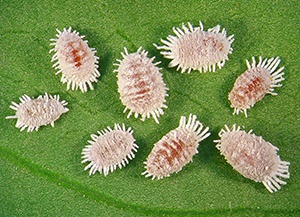
Mealybugs are pink, soft-bodied wingless insects that are covered in a white, waxy, cottony material. They appear on plant leaves and stems as white cottony masses. These bugs have long, sucking mouthparts that are called stylets, which are used to tap into plants and draw sap out of the tissue. Mealybugs range in size from 1/10” to 1/4” long.
Found in warmer growing climates, there are approximately 275 varieties of the mealybug across the United States. These plant suckers can cause problems in greenhouses, gardens and on indoor plants if higher numbers are present. Their feeding weakens plants and causes leaf yellowing and curling. Mealybugs also leave behind a sticky honeydew substance, which can lead to fungal diseases, if left unattended. Affected plants include ornamentals, houseplants, citrus fruits and avocadoes.
Visual inspection of plant leaves and stems is the best way to identify a mealybug infestation. Plants may look like they have cotton on them. On some plants, the pests may grow on the leaf tips, while other species of mealybug prefer to hide in the leaf whorls or stem crotches. There are also mealybugs that prefer to feed on roots, making them very difficult to identify without observing the root ball of the plant.
To control and eliminate mealybugs, be sure not to overwater or overfertilize, as these pests love new plant growth. Also, incorporate these organic control techniques:
- Use a moderately strong spray of water to dislodge most of the bugs or wipe off with a cotton swab dipped in rubbing alcohol.
- Carefully inspect new plants that you bring into the garden, keeping them separate from the rest of your plants for up to a week, if possible.
- Enlist the help of beneficial insects like ladybugs and lacewings to help combat the mealybug.
- Use Earth’s Ally Insect Control to suffocate mealybugs by covering the plant thoroughly, including leaves and stems. Be sure to pay particular attention to hard to reach places where mealybugs like to hide, like leaf whorls and stem crotches.
Leaf Rollers
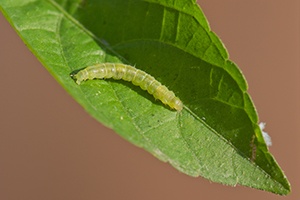
Leaf rollers are small green or brown caterpillars that feast on leaves, buds and fruit. In the larval stage, these pests look like long, slender worms or caterpillars, just under 2/3” in length. They differ from other caterpillars because they have a tendency to roll leaves of plants together with a silken web, where they like to hide, live and feast.
There are a number of different varieties of leaf rollers, found commonly on fruit trees and ornamental trees. They are rarely found in vegetable gardens. When leaf roller larvae take up residence in unfolded leaves, the foliage will turn brown and die. Adults and larvae also feed within berries and fruit (think worm in the apple) and may not reveal themselves until consumption.
You should begin monitoring your trees early to identify the presence of leaf rollers, looking for folded or rolled leaves in the plants. Leaves may be discolored or show small holes in the leaves, which are signs of feeding.
To control and eliminate leaf rollers, be sure to begin organic treatment no later than petal fall to keep the larvae from injuring developing fruit. Organic treatment includes:
- Remove all affected foliage as soon as signs of damage are discovered and throw it in the trash. Do not place in compost pile.
- Remove visible insects by hand and destroy them.
- Welcome native predators into your garden by mingling various pollinator-friendly plants and flowers. Parasitic wasps, lacewings and birds are all enemies of the leaf roller.
- Use Earth’s Ally Insect Control to suffocate leaf rollers by covering the plant or tree thoroughly, including leaves and stems.
Scale Insects
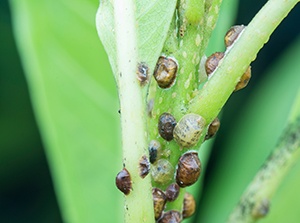
Scale insects are small, oval and flat. There are two types of scale insects: armored (hard) and soft. The armored type of scale insect is approximately 1/8” long and secretes a hard, protective coating over itself, which is tan to brown in color and not attached to the body. The soft scale insect is up to 1/2” long and secretes a waxy film that is part of the body. These oddly-shaped pests are mobile as nymphs (crawlers), but immobile as adults, resembling shell-like bumps instead of insects.
Over 1,000 species of scale insects exist in North America, inhabiting backyard trees, ornamental shrubs, greenhouse plants and houseplants. These are sap-sucking pests, attaching themselves to the undersides of leaves, branches and fruits of their hosts. The hard scale insects do not secrete honeydew, but soft scale insects produce excessive amounts of the sticky substance, which promotes growth of sooty mold, a black fungus that can interfere with photosynthesis in the plant. Scale insects thrive in warm, dry environments.
Scale insects can be found under leaves and at leaf joints. Plants affected by scale insects will look withered and sickly, with falling yellow leaves. The plants may also have a sticky sap or black fungus on leaves and stems and produce little new growth. Left unchecked, plant death is possible and scale insects will infest other plants.
To control and eliminate scale insects, observe the following organic gardening practices:
- Prune and dispose of infested branches and leaves.
- Small numbers of scale insects can be picked off of plants manually or dabbed with an alcohol-soaked cotton swab.
- Beneficial insects like ladybugs and lacewing are natural predators to scale insects in the crawler nymph stage.
- Use Earth’s Ally Insect Control on scale insects during the crawler stage, covering the affected plant thoroughly, including leaves and stems. Repeat weekly for a month for best results.
Spider Mites
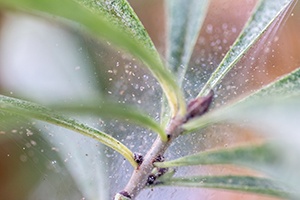
The spider mite is a tiny enemy of garden plants that is not really an insect, but a type of arachnid, related to spiders, scorpions and ticks. Adult spider mites are oval-shaped, reddish-brown or pale in color and only 1/50” long. Nymph spider mites look much the same, only smaller. Their size makes them very hard to detect in the garden.
Spider mites are very common throughout North America but tend to thrive in hot, dry conditions. They live in colonies, typically on the underside of leaves, feeding by piercing the leaf and sucking up plant fluids. They are very prolific pests, producing as many as 300 eggs over a few weeks, which can grow from egg to adult in as little as five days if weather conditions are right.
Greenhouses are especially susceptible to the destruction of the spider mite, but this pest attacks a variety of indoor and outdoor plants, including:
- Ornamentals, including roses
- Indoor houseplants
- Strawberries
- Melons
- Squash
- Beans
- Sugar peas
- Tomatoes
- Eggplant
- Cannabis and Hemp
Identification of spider mites can be challenging, due to their size. Visible damage begins to occur when infestations are large. Leaves may show patterns of tiny spots, which are the pests’ feeding marks. As feeding continues, the plant’s leaves will turn yellow and may curl and fall off. Tight webs found under leaves and along stems are a visible indicator that spider mites are present. While the spider mite does not have wings, it uses its webbing to surf along the wind and affect surrounding plants. This is why it is important to contain and dispose of affected plants to avoid further infestation.
To control and eliminate spider mites, an organic treatment is best. Chemical pesticides actually encourage the spread of spider mites by killing beneficial insects that prey on them. Use this organic approach for best results:
- Prune leaves, stems and all affected parts of plants (wherever webbing is found) and discard in the trash. Do not place waste in compost piles. When necessary, pull the entire plant to keep infestation from spreading.
- Spray affected plants with your garden hose to reduce the number of spider mites with water.
- Introduce beneficial insects like ladybugs, lacewing and predatory mites to assist with controlling pest levels.
- Keep plant leaves dust-free by incorporating a seasonal hosing in your garden maintenance schedule.
- Make sure plants are properly watered to avoid water stress, which makes plants susceptible to mites.
- Use Earth’s Ally Insect Control to suffocate spider mites by thoroughly coating the leaves and stems, including undersides. Apply in the early morning hours and never when temperatures exceed 90˚F.
We’d love to hear how Earth’s Ally is helping you grow healthy plants. Share your experience and stay connected with the #EarthsAlly community on Facebook, Instagram and Twitter for access to our latest blog posts, giveaways and exclusive promotions.
